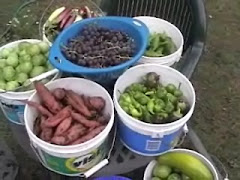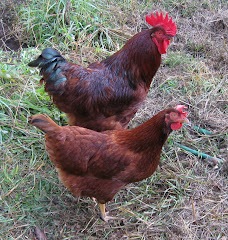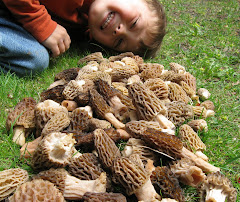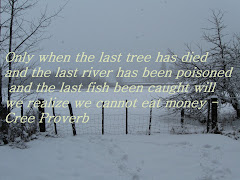I've read that Kabouli beans were discovered in Kabul Afghanistan and have been cultivated for thousands of years, a true heirloom. Now Baker Creek, whom I bought my original seeds from, states in their 2008 catalogue (pdf) that "This unique heirloom variety was collected in Kabul, Afghanistan. The 2’ plants produce unusual dark purple beans (mine were definitely black). The purple color comes from a pigment called anthocyanine, which enables seeds to sprout in cool soil, making this variety good for short season areas. Perfect for hummus and other Middle Eastern dishes."
But...
FEDCO states in their catalogue that although garbanzo beans in general originally hailed from Afghanistan "Black Kabouli was developed at Washington State University to be tolerant of cold soils and light frosts. The 2' plants with ornamental purple flowers bear abundant two-seeded pods resembling beach peas with black medium-sized beans."
Hmm?

As legend has it this bean is supposed to attract thunderstorms when blooming so I suppose inconsistencies regarding whether it is anthocyanines or WSU that brings out their cold heartiness is of little importance when one has to worry about being struck by lightning. Regardless, we not only grew them because of their cold tolerant nature but the fact that they are so small we should be able to use our hand powered grain grinder to pulverize them, saving us lots of time on quesadilla night as powdered beans are much quicker to prepare. I have not tried this yet.

The Kabouli beans were as productive as can be expected from a bean that only produces two seeds per pod.

The Delinel bush beans were very vigorous, providing us with numerous fresh green beans throughout the summer months. We did not save any for dried beans or seed (I forgot) so I have no pictures of the of the little black beans that reside in the mature pods.


Thompson Morgan insists that I must never eat these beans raw because they may make you sick. I was not aware of this and did indeed eat many of them raw without consequence. I was not sure if that was supposed to apply to all green beans or just my Delinels.
In all seriousness, I have never heard of this raw bean issue before so I looked up some information regarding the potential toxicity of raw green beans and found that they supposedly contain "Prussic (hydrocyanic) acid," aka Cyanide, which is rendered safe by cooking. Apparently some people can become quite sick after eating raw beans or bean seeds and may suffer from declining blood pressure, vomiting, stomach ache, circulation problems, convulsions, or even heart palpitations. It appears that the susceptibility to these reactions is hereditary, much like "Favism" is in Fava beans. I knew about Favism.
This may indeed be true, I am just surprised that I have been oblivious to the possible toxicity of raw beans. How very interesting. Going forward I think I will continue to "push the envelope" and risk eating raw green beans as I have done since a child. Some people climb mountains and others sky dive, I on the other hand, being the adventurous spirit that I am, eat green beans...raw.:) Please tell me that I am not the only person that was unaware of this?








 ...and to continue my ramblings about beans I thought I might share a few thoughts on some of our pole varieties. Among the new additions to our garden this past season were Purple Podded and Rattlesnake pole beans. Even with spring conditions
...and to continue my ramblings about beans I thought I might share a few thoughts on some of our pole varieties. Among the new additions to our garden this past season were Purple Podded and Rattlesnake pole beans. Even with spring conditions 


 In the end, Kentucky Wonder was my worst performer, normally it's my best. For more years than I can remember we have been saving their seed and growing these beans in a somewhat shady location in another garden plot. However, this year they were granted a prime location in the main garden. I almost wonder if the sun was too much for them, while this is highly
In the end, Kentucky Wonder was my worst performer, normally it's my best. For more years than I can remember we have been saving their seed and growing these beans in a somewhat shady location in another garden plot. However, this year they were granted a prime location in the main garden. I almost wonder if the sun was too much for them, while this is highly  Something I did notice this summer was how harsh the sun was on many of our plants, even burning and drying some of the leaves...and our garden is pretty shaded as it is. The eggplants, although they put out a superior product, looked less than lovely because of this and many of our
Something I did notice this summer was how harsh the sun was on many of our plants, even burning and drying some of the leaves...and our garden is pretty shaded as it is. The eggplants, although they put out a superior product, looked less than lovely because of this and many of our 




 A couple of the varieties we grew were our long standing favorites, Painted Lady and Scarlet Emperor runner beans; provided with proper support they can grow upwards of 15'. I grew most of them along an 11' high fence and also set up a couple very tall poles which all of the plants where able to summit before fall...not so easy to pick that way. Apparently you are supposed to pick runner beans very regularly in order to keep the pods from reaching maturity as this will prevent flowers from forming. We don't, as our runner beans are used for dry soup beans and we still seem to get quite a few per plant.
A couple of the varieties we grew were our long standing favorites, Painted Lady and Scarlet Emperor runner beans; provided with proper support they can grow upwards of 15'. I grew most of them along an 11' high fence and also set up a couple very tall poles which all of the plants where able to summit before fall...not so easy to pick that way. Apparently you are supposed to pick runner beans very regularly in order to keep the pods from reaching maturity as this will prevent flowers from forming. We don't, as our runner beans are used for dry soup beans and we still seem to get quite a few per plant.






 As you can see, there is quite a difference in size between the Mongolian and volunteer seeds
As you can see, there is quite a difference in size between the Mongolian and volunteer seeds
 Removing the seeds and filling our bins...a slow arduous task to say the least:)
Removing the seeds and filling our bins...a slow arduous task to say the least:)

 I picked a grand salad last night, full of hearty greens that become all the more flavorful in the coolness of Autumn. In this years winter gardens we are growing Tuscan, Russian, Blue Curled, and Lacinato Rainbow kale the first being the least hardy of the bunch.
I picked a grand salad last night, full of hearty greens that become all the more flavorful in the coolness of Autumn. In this years winter gardens we are growing Tuscan, Russian, Blue Curled, and Lacinato Rainbow kale the first being the least hardy of the bunch.
 Underneath the row covers one will also find Treviso radicchio, a plant that performs marvelously in the late fall and early spring gardens in part, I believe, because of its long tap roots that help to give it staying power...as long as the voles don't find them.
Underneath the row covers one will also find Treviso radicchio, a plant that performs marvelously in the late fall and early spring gardens in part, I believe, because of its long tap roots that help to give it staying power...as long as the voles don't find them.
 Red Veined sorrel may be on of the least flavorful additions to the garden but given its beauty and enduring nature how can we possibly resist growing it? Once established this plant will readily re-seed itself...everywhere.
Red Veined sorrel may be on of the least flavorful additions to the garden but given its beauty and enduring nature how can we possibly resist growing it? Once established this plant will readily re-seed itself...everywhere.
 Two of this years cold frames have transplanted radicchio and seeded arugula in them, we have quite a bit of luck getting arugula seedlings to overwinter and provide nice greens for late February salads.
Two of this years cold frames have transplanted radicchio and seeded arugula in them, we have quite a bit of luck getting arugula seedlings to overwinter and provide nice greens for late February salads.
 A couple other plants that have recently surprised us with their cold hearty nature are the liquorice flavored chervil and Ruby Streaks mustard. Both are rather feathery and fine without much bulk but do impart a nice combination of flavors.
A couple other plants that have recently surprised us with their cold hearty nature are the liquorice flavored chervil and Ruby Streaks mustard. Both are rather feathery and fine without much bulk but do impart a nice combination of flavors.













